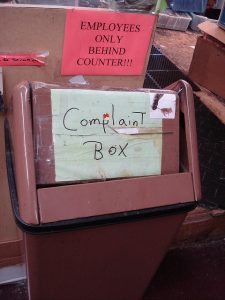In March I discovered the catchy, learner-friendly song “El perdón” and blogged about ways to use it in both novice and intermediate classes. That post was the 5th-most popular post of 2015.
New song: El perdón for two levels

Ever feel behind the times? I just caught the current #1 song on Latin Billboard and it struck me as having two golden ingredients for a good class song:
- high student appeal and
- a couple of high frequency structures repeated.
(Though I wanted to say, Dude – she moved on, she’s happy, get over it! Ha.)
Two repeated structures in particular in this song shine with opportunities to get students talking, even students on different levels. Here are some suggestions for what to do with the song “El perdón,” a collaboration by Nicky Jam and Enrique Iglesias.
Lower novice: gripes
Invite lower novices to practice complaining – they’ll love that, right? Focus on the repeated structure from the chorus: Es que _________, dime ¿quién puede ser feliz? Esto no me gusta. ¡Esto no me gusta!
Here’s my clip of that:
I put the structure at the end. Model using your own simplified complaints, then invite those who are ready to help build a class list. See if any extroverts are willing to actually sing the line with one of the sample complaints. Finally, ask students to make their own and present (sing?) it. As an extension, create a survey or poll for students to ask and answer questions to find out what everyone’s complaining about.
It’s neither healthy nor friendly to be so negative, though, right? Tell students, okay, enough complaining – we can just as easily make this about talking about what’s going great; all we do is remove the no and replace with sí – “Es que _______, esto sí me gusta, esto SÍ me gusta!” (Got any ideas for adjusting that middle phrase?)
Higher novice / Lower intermediate:
What was happening and what is happening? Students can use this repeated structure to talk about what they were doing yesterday (Intermediate Low) and what is happening to them today (Novice High): estaba _____ando/iendo, por (un lugar) _______ando/iendo, [hoy estoy] _____ando/iendo. Something like that. You get the idea. Here’s that clip.
And now, for the unfortunate fine print…
For these two guys, the lyrics were surprisingly clean. BUT in the main part of the chorus there is a terribly unfortunate use of “como un loco tomando.” Drinking your pain away is not a message for the classroom; I left Nicky Jam’s half of the chorus out of my clip on purpose. But that doesn’t mean I’d leave it out of the discussion. Phrases like that can be a great springboard for deep and responsible thinking!
For these two guys, the video could be a lot worse, but it’s not appropriate for my classroom anyway. Among other issues: the barely clad bicyclists with the headlamps, I’ve got no idea what that’s about. If you want to play the whole song, you can easily find a different video, a performance or lyric video.
The song and video for “El perdón” are copyrighted material and the clips I made for Edpuzzle are for brief educational use only. I think all Spanish teachers should use Latin pop music in the classroom, and I also think we should all model responsible consumerism, purchasing legal music and encouraging students to do the same. I don’t agree with everything these guys do, but they work for their money.
Photo:

2 Comments
Comments are closed.




I enjoy reading about how other teachers are using EdPuzzle, because I’ve just started using it. You mentioned copyright infringement. My understanding is that the way EdPuzzle works is it uses YouTube’s API. It does not strip the video from its original YouTube player; it’s kind of like embedding the video on your page, but adding a few features. Using a YouTube video on EdPuzzle, assuming the uploader had the rights to upload the video to YouTube, would not be copyright infringement. Since this seems to be an official YouTube video uploaded by the artist that you’re using, it’s fine. If the students really like the song and wanted to download a copy for their iTunes library, then they would need to purchase it from Amazon or iTunes.
Thanks for this clarification, Samantha!